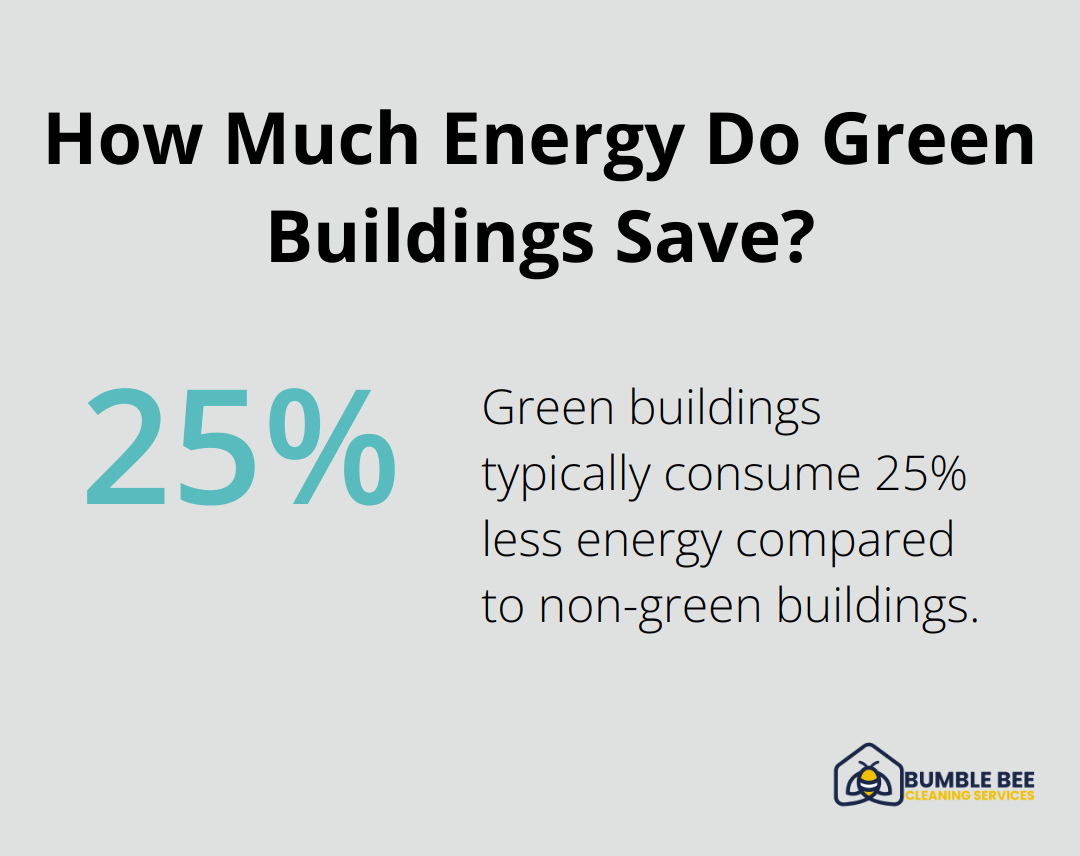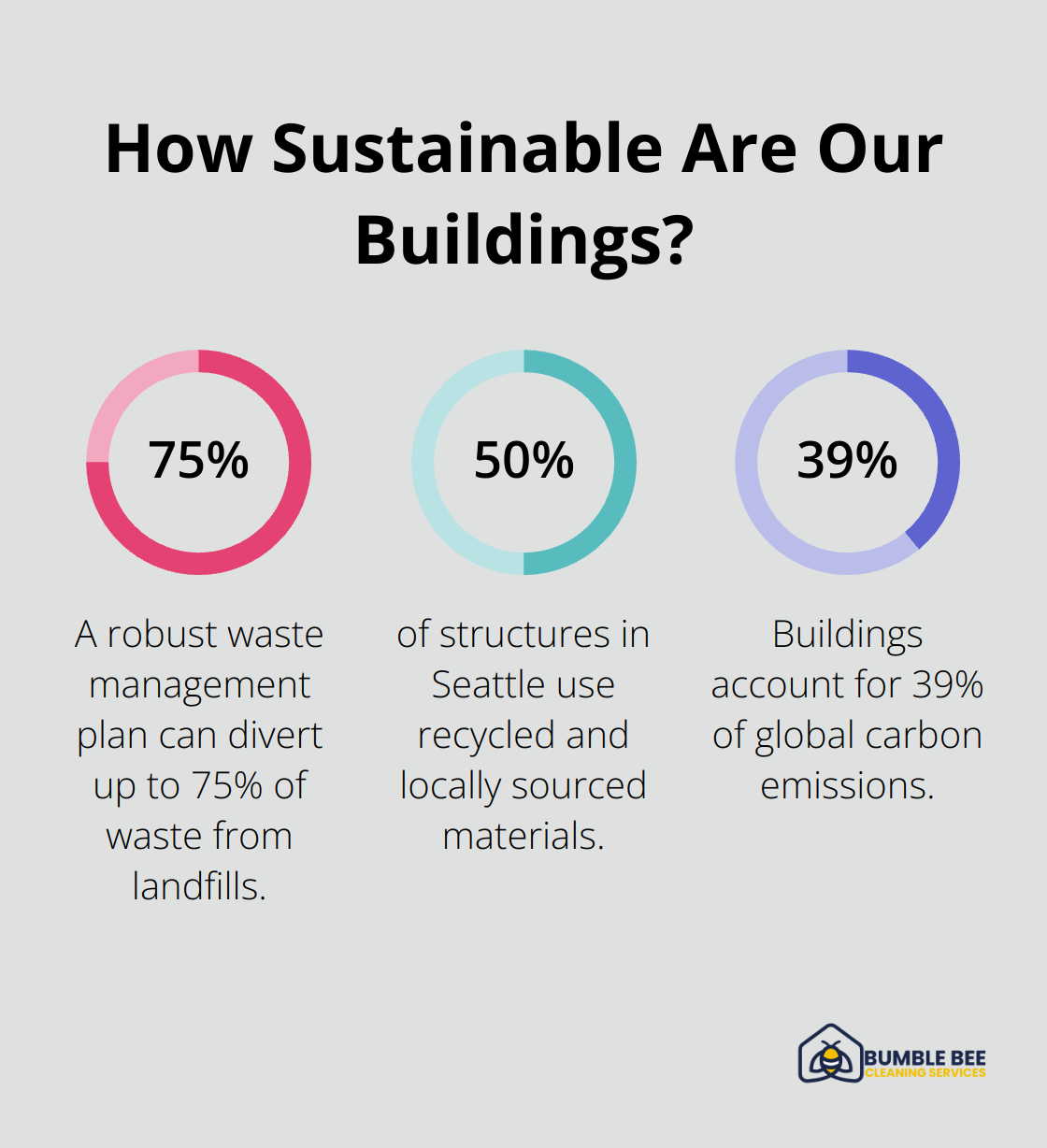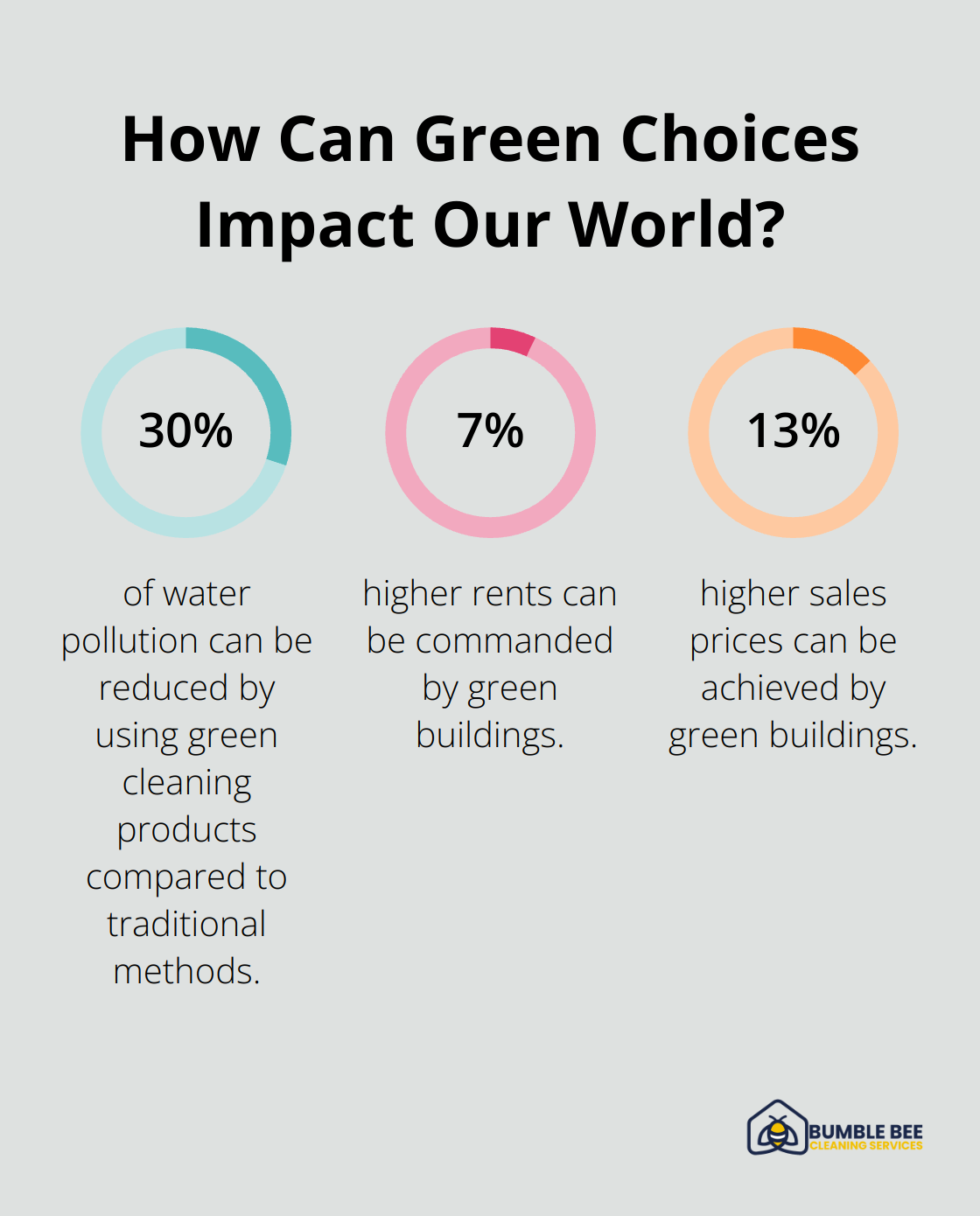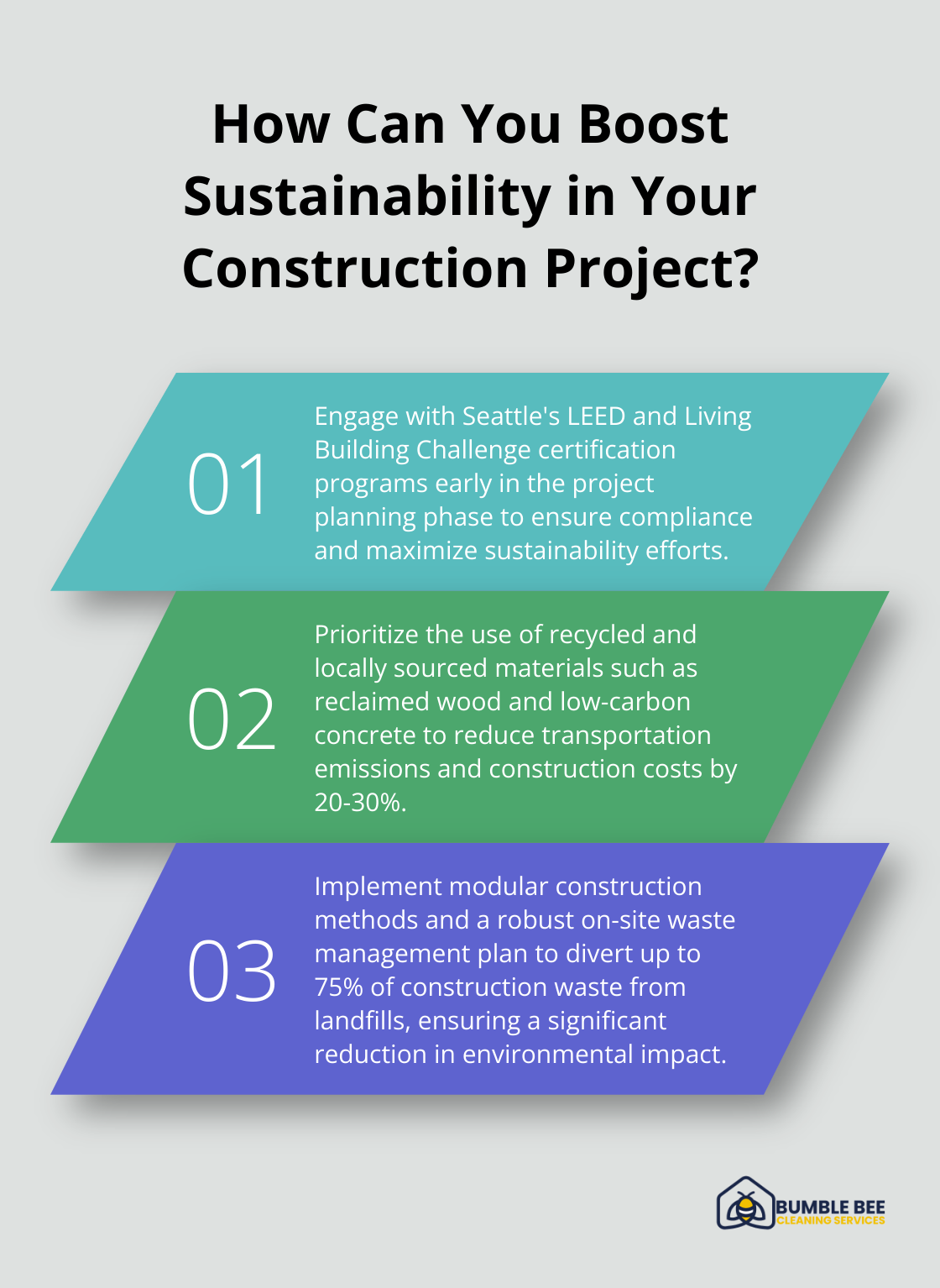Seattle is at the forefront of green building standards, promoting sustainable construction practices to protect our environment.
Adopting eco-friendly methods isn’t just a trend; it’s a necessity.
Here at Bumble Bee Cleaning Services, we are passionate about supporting these initiatives through our eco-friendly post-construction cleanup services.
What Are Seattle’s Green Building Standards?
Seattle boasts some of the most advanced green building programs in the nation, aimed at leading the way in sustainable construction. These initiatives are vital for reducing our carbon footprint and protecting the local environment.
Overview of Certification Programs
Seattle’s green certification programs encourage builders to integrate sustainable practices that reduce environmental impact. The two most notable programs are the Leadership in Energy and Environmental Design (LEED) and the Living Building Challenge.
LEED Certification is widely recognized and provides a framework for energy-efficient and sustainable buildings. Projects earning LEED certification are designed to use less water, reduce greenhouse gas emissions, and save energy costs. In Seattle, over 400 buildings are LEED-certified, highlighting the city’s commitment to sustainable development.

The Living Building Challenge is one of the most rigorous standards, pushing for regenerative design that goes beyond sustainability. Buildings meeting this challenge generate more energy than they consume and treat all wastewater on-site. There are only a handful of Living Building Challenge-certified projects in Seattle, such as the Bullitt Center, showcasing the city’s leadership in innovative green building.
Key Requirements and Best Practices
Achieving these certifications involves several core requirements. For instance, LEED-certified projects must meet prerequisites and earn points across various categories, including water efficiency, energy use, materials selection, and indoor environmental quality. These categories ensure a holistic approach to sustainability.
For those aiming to meet Living Building Challenge standards, the requirements are even more stringent. Highlights include achieving net-positive energy and water balances, reducing the building’s ecological footprint, and using only non-toxic materials. A study by the U.S. Green Building Council found that green buildings typically consume 25% less energy compared to non-green buildings, leading to significant long-term savings.
Builders in Seattle are increasingly adopting practices like using reclaimed materials, integrating green roofs, and employing energy-efficient HVAC systems. For example, the use of low-VOC paints significantly improves indoor air quality, while green roofs help manage stormwater and reduce urban heat islands.
Practical Steps for Builders and Developers
To successfully navigate Seattle’s green building landscape, it is essential to engage with these certification programs early in the project planning phase. Builders should seek guidance from experienced professionals who are familiar with the specific criteria and documentation required.
Moreover, staying updated with Seattle’s green building regulations and incentives can prove beneficial. The city offers various rebates and incentives for green building projects, which can offset some of the initial costs associated with sustainable construction.
Attending workshops and training sessions provided by the Seattle Department of Construction and Inspections can also offer valuable insights and practical knowledge. These sessions often cover the latest trends and best practices in sustainable building, ensuring projects align with the highest environmental standards.
In conclusion, Seattle’s commitment to green building standards is evident through programs like LEED and the Living Building Challenge. By adopting these programs, builders and developers can contribute to a more sustainable future while also experiencing financial and ecological benefits.
What Makes Sustainable Construction Effective?
Sustainable construction practices are essential for creating eco-friendly buildings in Seattle. Implementing these methods not only benefits the environment but also enhances long-term economic benefits and occupant health.
Using Recycled and Locally Sourced Materials
Incorporating recycled and locally sourced materials is a game-changer for sustainable construction. About 50% of structures in Seattle use such materials to cut down on transportation emissions and support the local economy. Builders should prioritize materials like reclaimed wood, recycled steel, and low-carbon concrete. These materials reduce reliance on new resources and significantly lower the carbon footprint. For instance, using reclaimed materials can reduce overall material costs by 20-30%, making it both an eco-friendly and cost-effective option.
Energy-Efficient Design and Technology
Energy-efficiency is not optional; it’s critical. Buildings account for 39% of global carbon emissions, and energy-efficient design can slash this drastically. Seattle is already a leader, with buildings integrating smart technologies such as sensor-based energy management systems. These systems optimize energy use by adjusting lighting, heating, and cooling based on occupancy. Studies show that such technologies can reduce energy consumption by up to 30%, leading to lower operational costs and a smaller environmental impact. Passive solar design, high-performance windows, and insulated walls are also key elements in minimizing energy use.
Waste Reduction and Management
Waste reduction during construction is crucial. On average, construction projects generate 50-80 pounds of waste per square foot. Implementing a robust waste management plan can divert up to 75% of this waste from landfills. Practices include on-site sorting of waste, recycling scrap materials, and donating surplus. Seattle’s construction sites increasingly adopt these measures. Adopting modular construction methods can further reduce waste by creating components off-site, which leads to precise material usage and less on-site scrap.

Embracing these sustainable construction practices sets a high standard for eco-friendly development. By using recycled and local materials, integrating energy-efficient technologies, and focusing on waste reduction, Seattle continues to lead in green building.
Why Invest in Eco-Friendly Post-Construction Cleanup?
Reducing Environmental Impact
Eco-friendly post-construction cleanup minimizes harm to the environment, a critical concern in a city like Seattle. Traditional cleanup methods often involve harsh chemicals, contributing to water pollution and harm to local wildlife. By choosing biodegradable and non-toxic cleaning agents, we help decrease the release of hazardous substances into Seattle’s delicate ecosystems. For instance, a study by the Environmental Protection Agency (EPA) showed that green cleaning products can reduce water pollution by 30%, set against traditional methods. Embracing sustainable cleanup practices means using products that meet these standards, ensuring a lesser ecological footprint. For more information on how to choose the right biodegradable cleaning agents, you can refer to this essential guide.
Improving Indoor Air Quality
The chemicals used in conventional post-construction cleaning can linger in the air long after the job is done, contributing to poor indoor air quality. This is especially adverse in a humid city like Seattle, where mold and mildew can thrive. Green cleaning products, certified by Green Seal, do not release volatile organic compounds (VOCs), which can cause respiratory issues. According to the World Health Organization (WHO), poor indoor air quality is linked to a variety of health problems, including asthma and bronchitis. By using eco-friendly cleaning methods, indoor air quality improves significantly, creating a healthier indoor environment for occupants and reducing potential health issues. If you are interested in all-natural cleaning products that avoid harmful VOCs, check out what to look for in all-natural cleaning services.
Enhancing Property Value
Investing in eco-friendly post-construction cleanup can amplify property value. Properties that meet sustainable standards are increasingly in demand, reflected in higher property values and rental yields. According to a report by the U.S. Green Building Council, green buildings can command 7% higher rents and 13% higher sales prices compared to traditional buildings. This is attributed to lower operating costs, improved indoor environments, and the growing preference for sustainable living. By integrating green cleaning practices immediately after construction, properties are more likely to achieve higher LEED ratings and other certifications, further boosting their market appeal and demonstrating a commitment to sustainability. To maintain property value and ensure sustainable living, consider monthly cleaning services that use eco-friendly products and practices.

Conclusion
Sustainable construction in Seattle is not merely a choice; it’s a commitment to a healthier environment and community. By integrating eco-friendly practices such as using reclaimed materials, energy-efficient designs, and robust waste management plans, builders can significantly reduce environmental impacts while also enjoying long-term economic benefits.

Adopting green standards aligns closely with Seattle’s values and provides tangible advantages like improved indoor air quality and enhanced property value. With buildings accounting for a significant portion of global carbon emissions, it’s critical to implement sustainable methods from the initial planning stages to the final cleanup.
At Bumble Bee Cleaning Services, we support these green initiatives with our dedicated eco-friendly post-construction cleanup services. We use non-toxic, biodegradable products to ensure that new buildings retain their sustainability goals even after the construction phase. You can learn more about our services and commitment to eco-friendly practices here.
In conclusion, the drive towards sustainable building in Seattle signals a forward-thinking approach that benefits everyone—residents, businesses, and the environment. By continuing to embrace and innovate within the realm of green construction, we can all contribute to a more sustainable and prosperous future.
